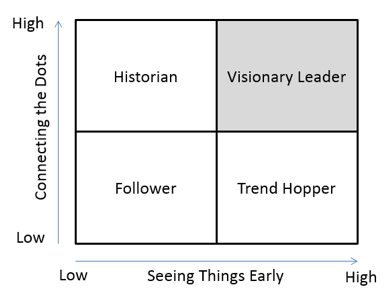
Visionary leaders energise followers with purpose and meaning.
Rob-Jan De Jong in his book; Anticipate: The Art of Leading by Looking Ahead said, â€Visionary leaders share two things in common:
- Visionary leaders see things early
- Visionary leaders connect the dots.â€
The great news is that visionary leadership is a skill and YOU can build your own visionary capacity.Â
In his book, Rob-Jan De Jong explains some ways in which we can each build our visionary capacity.
Visionary Leaders See Things Early
To practice visionary leadership, you need to see what’s coming. You need to be able to filter through all the noise and zoom in on what’s pertinent and probable.
 “Your ability to see things early. The first signs of change often manifest as random noise or faint warning signals, often at the periphery of our attention and far less explicit in their game-changing nature than they are later. Growing your ability to notice these signals early, and recognize their potential impact, is an essential part of raising your visionary capacity.â€
Visionary Leaders Connect the Dots
To practice visionary leadership, not only do you need to see things early, you need to make it meaningful, and put things into context. You need to be able to shape and sell a relatable story.
  “Your ability to connect the dots, to create coherence in the future you face and turn it into a bigger picture’ story. This implies constructively and intelligently working through the complexity of the multi-faceted and multi-dimensional future.â€
Visionary Development Framework
Rob-Jan De Jong shares a simple way to visualize the two dimensions of Visionary Leadership and to compare and contrast with what he calls Historians, Followers, and Trend Hoppers.

Followers (are not Visionary Leaders)
It’s tough to lead from behind. Followers often don’t see things early enough, and they don’t connect the dots in a meaningful or relatable way.
 “In the lower left quadrant, we find the Follower: someone neither very good at early noticing nor skilled in creating and communicating a coherent story from the various insights he or she has about what the future might bring.
This is not to say that Followers don’t have any idea of what the future might bring for their part of the organisation or industry. They just don’t have a compelling story or image ready to share when provided an opportunity to ignite others. It’s either absent, poorly developed and unformulated, or all over the place and lacking coherence. The Follower may well be a wonderful person and an excellent manager, but don’t expect this person to be a rich source of inspiration, to drive innovation, fuel fresh breakthrough ideas, or help others overcome mental barriers in order to go beyond today’s reality.â€
Trend Hoppers (are not Visionary Leaders)
Trend Hoppers hop from trend to trend. Trend Hoppers are fun for Fridays, but we pay attention to the Visionary Leaders on Mondays.
 “Those in this category (lower right quadrant) are less likely to develop true leadership profiles. After chasing several flavour-of-the-month ideas, many people mentally tune out with the Trend Hopper and become reluctant to chase yet another ground breaking’ idea or development. Trend Hoppers, are therefore ineffective in the long run in engaging the organisation, mostly because they do not successfully integrate their early insights into a larger context that provides coherence. They are the kind of people we like to listen to on Friday afternoon, but not on Monday morning.â€
Historians or Cynics (are not Visionary Leaders)
While a visionary has 20/20 foresight, historians have 20/20 hindsight. They are good at telling stories about what has already happened.
“Which brings us to the upper left quadrant, the leaders adept at connecting the dots and spinning the story that makes sense. They like to cite patterns, facts, and figures–ideally in PowerPoint–and marvel at making the road travelled so far look very coherent and intentional. When you listen to them, it all makes sense. But they have their eye trained on the factually true past, not on the imaginative uncertain future. They’re not very good at spotting where the early signals are coming from and how these could become potential game changers. I call them the Historians. They have a strong thinking preference for consistency and logic, and are therefore less interested in what breaks with coherence (unlike Trend Hoppers). Their focus is on making everyone understand why we are where we are today by integrating past events into a logically consistent perspective.â€
The Visionary
The Visionary Leader can connect the future and what’s coming to the present, and tell a bigger story of how the puzzle pieces fit together.  They inspire others toward a more meaningful outcome.
 “A quote attributed to Albert Schweitzer says that an optimist is a person who sees a green light everywhere, while a pessimist sees only the red stop-light… The truly wise person is colour-blind.’ I’d like to extend the metaphor and let our visionary be colour-blind. The visionary would not overoptimistically jump on every fad that passes by, as our Trend Hopper risks. Nor would he become a naysayer and launch into the Historian mode. The visionary takes a mindful, future-oriented perspective, balancing the need for a compelling future with the awareness of the inherent dangers of becoming dogmatic and overoptimistic.â€
Relevance vs. Implication
While visionary leaders need to both see things early and connect the dots, they need to keep things in balance. This is how they gain the advantage of both knowing what’s relevant and knowing the implications.
 “Because we’re operating on constant information overload, it’s vital that we filter out what’s important and what’s not. The ability to see early depends on judging weak signals according to the relevancy they represent. Without specific effort, you will only be able to identify manifestations of change in retrospect. But that’s usually when it’s too late.Â
 The ability to connect the dots, though, is focused on implications of changing realities. It takes the ideas generated from the early noticing ability and integrates them with other important factors, putting the early signals of a changing reality into perspective and making them logically consistent. The resulting story is then complete to potentially serve as a powerful vision.â€
Data Point vs. Model
Visionary Leaders are able to make sense of a bigger model that explains how things fit together, as well as understand the data points that support the model, and even the outliers that may seem to contradict the model.
“Sometimes one data point can defy all the logic in the model. Even though it represents a different and often unwanted reality, it’s the outlier that must be considered in serious planning. The ability to connect the dots isn’t enough.  A model, like a vision, requires an understanding of the relevance of single data points in addition to the model, even if these points are outliers. Especially if they happened just twelve months earlier.â€
Focus on Detail vs. Focus on Helicopter View
Visionary Leaders are able to zoom in and zoom out to keep everything in perspective, to drill in to the meaningful details, and pan out so they can see how things relate, as well as what’s important vs. what’s just noise.
 “The third core difference between seeing things early and connecting the dots is a behavioural one. The ability to see things early requires astute attention to detail. You need to filter the signal from the noise, focusing on one or possibly a few weak signals that are undetected by most. The ability to create a coherent story, however, takes a helicopter view. A generalist who isn’t hampered by too much attention to detail can understand the implications of various developments and connect them in a logical, compelling story.
Developing both abilities requires the skills and focus of the specialist and the generalist. You must consider the relevance and potential consequences of rather vague, weak signals and then step into the helicopter and combine the signals with larger, possibly macroeconomic, trends and developments at play in the world and your industry.â€
Risk Seeking vs. Risk Aversion
Visionary Leaders are able to balance risk-seeking with risk-aversion so that they know the better bets and how to invest, while taking calculated risks, and mitigating damages. In other words, they balance the risk of doing something with the risk of doing nothing, based on what the future likely holds.
“Your ability to identify change is about looking beyond the conventional and questioning the way things are as they are today. Hence, a challenging, risk-seeking stance. Your ability to connect the dots is more conservative and risk-averse, however, since it looks for a coherent bigger picture. In other words, it forces you to be mindful about the stance you take and not bet the house over attractive yet highly speculative views brought to you by your improved ability to identify early changes.â€
Â
View the previous blog – Who Creates Vision… Next Blog we will explore creating buy-in and co-creating vision.
Â
